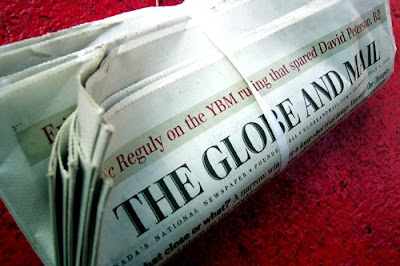The Globe’s desperately seeking the avoidance of clarity on tax leakage from the get go.
Stress test results provide ‘clarity'
SINCLAIR STEWART AND BOYD ERMAN
Globe and Mail
May 7, 2009 at 8:25 PM EDT
For the first time since the credit crisis erupted, the Obama administration has quantified the trouble facing the U.S. financial industry, saying its long-awaited stress tests show that 10 of the country's largest banks must raise $75-billion (U.S.) in fresh capital.
The results of the federal government's study, which gauged the ability of 19 big banks to withstand a deep recession, were more benign than many observers had expected. The findings should provide a measure of certainty to investors, and at the same time draw a clear line between the strongest and weakest institutions.
For the nine strongest, including JPMorgan Chase & Co. [JPM-N] and Goldman Sachs Group Inc., [GS-N] the tests are an important validation that will set the stage for them to repay their government loans, and extricate themselves from Washington's embrace.
“There is a reassurance in clarity,” U.S. Treasury Secretary Timothy Geithner said. He added that the details provided in the report should reassure large private investors about taking substantial stakes in banks, easing the government's financing burden.
Capital One
“That will make it possible for more capital to come into the financial system,” he said. “That will make it easier for banks to be in a position to ultimately repay the government.”
However, should the banks falter in their plans to raise cash, Washington said it would once again be there to prop up the sector with more money.
The tests were designed to forecast how the top 19 U.S. banks, with more than $2-trillion in total assets, would fare if the economic picture deteriorated over the next year. Under this gloomy scenario, regulators estimated these banks could lose as much as $600-billion in 2009 and 2010, leaving them with a combined capital shortfall of $75-billion.
One of the striking facets of the stress test plan is the willingness of Washington to differentiate between haves and have-nots, something policy makers have scrupulously avoided during the crisis.
When Washington initiated its Troubled Asset Relief Program in the fall, it compelled all the major banks to take government aid money, fearing that, if they didn't, investors might stage a run on the most fragile lenders.
But yesterday's stress test results suggest the Treasury Department and the U.S. Federal Reserve Board are confident that the weaker banks are resilient enough now to be singled out without jeopardizing their survival.
“The results released today should provide considerable comfort to investors and the public,” Fed chairman Ben Bernanke said.
The question now is how these banks will attempt to address their capital deficiencies – and whether their efforts to raise money will, in some cases, place them more firmly within Washington's grasp.
Bank of America Corp. [BAC-N] emerged as the most needy of the country's big banks, and must find $34-billion in additional capital to ward against potential losses. If it converts some of its preferred shares into common stock, the government may end up becoming one of its largest shareholders.
Bank of America said it doesn't expect to go begging to the government again, and will sell common stock and assets to bridge the gap. “We are comfortable with our current capital position in the present economic environment,” said Ken Lewis, the bank's CEO.
Wells Fargo & Co. [WFC-N], which needs to raise $13.7-billion, announced late yesterday it will try to sell $6-billion in shares.
Citigroup Inc. [C-N], which faces a $5.5-billion shortfall and has been heavily reliant on government bailout funds, said yesterday it will expand a program to convert preferred shares into common equity to cover that gap.
The options are murkier for GMAC LLC [GOM-N], an auto finance company at the heart of the government's plans to revive General Motors Corp. and rescue Chrysler LLC. It needs $11.5-billion, and analysts are uncertain as to where the financing arm will find it.
Smaller lenders such as Fifth Third Bancorp, KeyCorp., Regions Financial Corp. and SunTrust Banks Inc. must raise between $1-billion and $3-billion apiece.
The nine who were given a clean bill of health include Goldman, JPMorgan, Bank of New York Mellon, MetLife Inc., American Express, State Street Corp., BB&T, U.S. Bancorp and Capital One Financial.
Although investors reacted positively to the results in after-hours trading, some critics have contended the government's worst-case scenario – a 3.3-per-cent decline in the economy, 10.3 per cent unemployment, and a 22-per-cent drop in housing prices – wasn't nearly gloomy enough.
Some of the banks, meanwhile, have insisted the stress tests were unreasonably pessimistic in their assumptions, and forced them to take capital they didn't need.
Mr. Bernanke alluded to this recently, saying that, in designing the test, the government had to steer a safe passage between Scylla and Charybdis, the mythological sea monsters.
Thursday, May 7, 2009
Clarity: Everything the Globe and Mail seeks to avoid on tax leakage
Posted by
Fillibluster
at
10:25 PM
![]()
![]()
Subscribe to:
Post Comments (Atom)




1 comment:
I am glad to see that the Globe supports the protection of investors thru the clarity afforded by the bank stress testing in the US.
It is just too bad that this paper did not feel the same way about Canada & push for clarity & accountability when it came to the implementation of gov`t tax policy---I think that we deserve at least this much.
A trust tax will be in place come 2011 & media types like the Globe have done very little to parse the basics behind the tax law itself & very little to see if it based upon fact or Finance Department fiction.
Falling in-line with the gov`t because your ownership demands it , is no way to run a reputable paper.
Dr Mike Popovich
Post a Comment